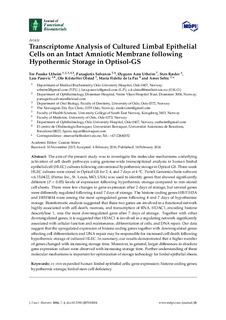| dc.description.abstract | The aim of the present study was to investigate the molecular mechanisms underlying activation of cell death pathways using genome-wide transcriptional analysis in human limbal epithelial cell (HLEC) cultures following conventional hypothermic storage in Optisol-GS. Three-week HLEC cultures were stored in Optisol-GS for 2, 4, and 7 days at 4 °C. Partek Genomics Suite software v.6.15.0422, (Partec Inc., St. Louis, MO, USA) was used to identify genes that showed significantly different (P < 0.05) levels of expression following hypothermic storage compared to non-stored cell sheets. There were few changes in gene expression after 2 days of storage, but several genes were differently regulated following 4 and 7 days of storage. The histone-coding genes HIST1H3A and HIST4H4 were among the most upregulated genes following 4 and 7 days of hypothermic storage. Bioinformatic analysis suggested that these two genes are involved in a functional network highly associated with cell death, necrosis, and transcription of RNA. HDAC1, encoding histone deacetylase 1, was the most downregulated gene after 7 days of storage. Together with other downregulated genes, it is suggested that HDAC1 is involved in a regulating network significantly associated with cellular function and maintenance, differentiation of cells, and DNA repair. Our data suggest that the upregulated expression of histone-coding genes together with downregulated genes affecting cell differentiation and DNA repair may be responsible for increased cell death following hypothermic storage of cultured HLEC. In summary, our results demonstrated that a higher number of genes changed with increasing storage time. Moreover, in general, larger differences in absolute gene expression values were observed with increasing storage time. Further understanding of these molecular mechanisms is important for optimization of storage technology for limbal epithelial sheets | nb_NO |

